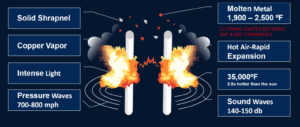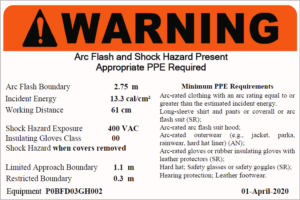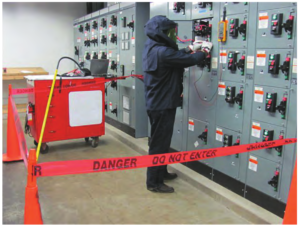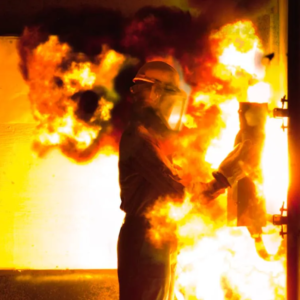Arc flash is the phenomenon of releasing a huge amount of heat energy when an electrical short circuit occurs such as a 3-phase short circuit, 2-phase short circuit, 1-phase short circuit to ground… due to a conductive object touching between energized phases or a short circuit due to a discharge between energized phases due to the insulating medium becoming conductive due to insulation degradation. The released heat energy has a temperature of up to 35,000 degrees F, which will heat up the air and melt the metal, creating an electric arc explosion. It also releases components such as: High-intensity pressure, high-intensity sound, high-intensity light, debris, toxic vapors. Arc flash can cause serious injury to the operator including severe burns, collapsed lungs, loss or impairment of vision, perforated eardrums,… and can even lead to death.
Arc flash hazard analysis will analyze and calculate the maximum heat energy released (Cal/cm2 or J/cm2) at the busbar locations of medium voltage cabinets, low voltage cabinets, switching equipment, power supply equipment, etc. and determine the necessary parameters and information to provide to the operator to operate the equipment such as: operating voltage, working distance, arc and electric shock protection zone, personal protective equipment.

♦ Performing an arc flash analysis provides the following necessary information and benefits:
– Determine the incident energy level under different operating conditions and scenarios.
– Calculate and minimize the incident energy level to ensure it is within the allowable regulations according to safety standards.
– Determine safe operating distances and areas such as arc flash protection boundary, electric shock protection boundary, and working distances.
– Apply warning labels in compliance with NFPA 70E safety standards.
– Select personal protective equipment to protect against arc flash and electric shock.
– Develop a process to control electrical risks and hazards.
♦ Provides information for selecting personal protective equipment. The use of personal protective equipment is the least effective risk control measure but is the last resort to protect operators from arc flash and electric shock hazards. Required protective equipment includes:
– Eye protection
– Hearing protection
– Head protection
– Full body protection
– Hand and arm protection
– Leg and foot protection
♦ Provide essential information about arc flash and electric shock hazards with arc flash labels. Arc flash labels provide operators with information to conduct hazard assessments before safely performing work, including:
– Incident energy level
– Operating voltage
– Working distance, arc flash boundary, limited approach boundary, restricted approach boundary
– Minimum personal protective equipment

 ♦ Applicable standards
♦ Applicable standards
– IEEE 1584: Standard for Arc Flash Calculations
– NFPA 70E: Standard for Electrical Safety in the Workplace
– OSHA: Occupational Safety and Health Administration



